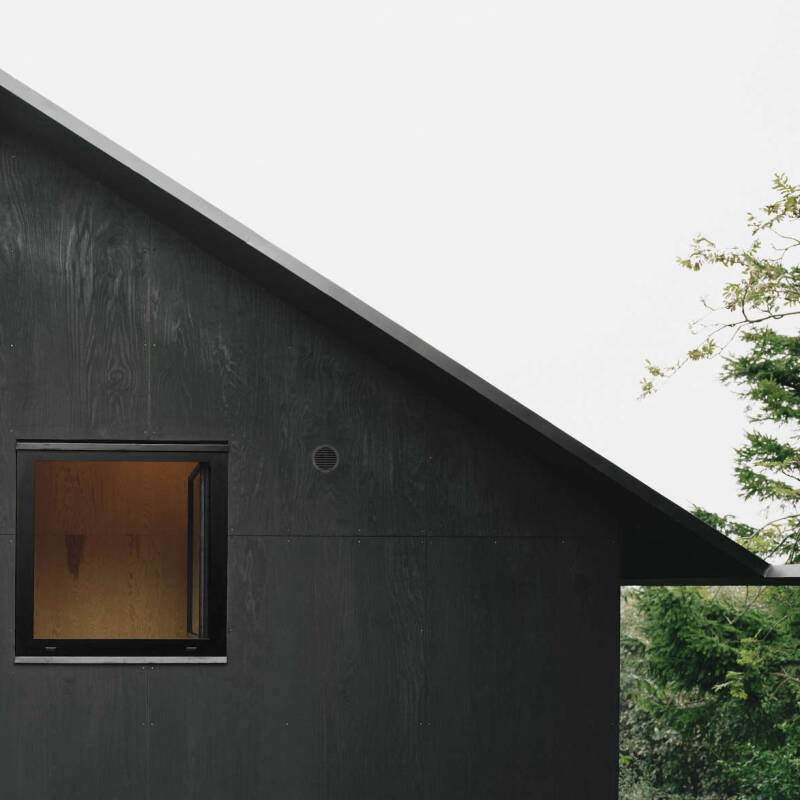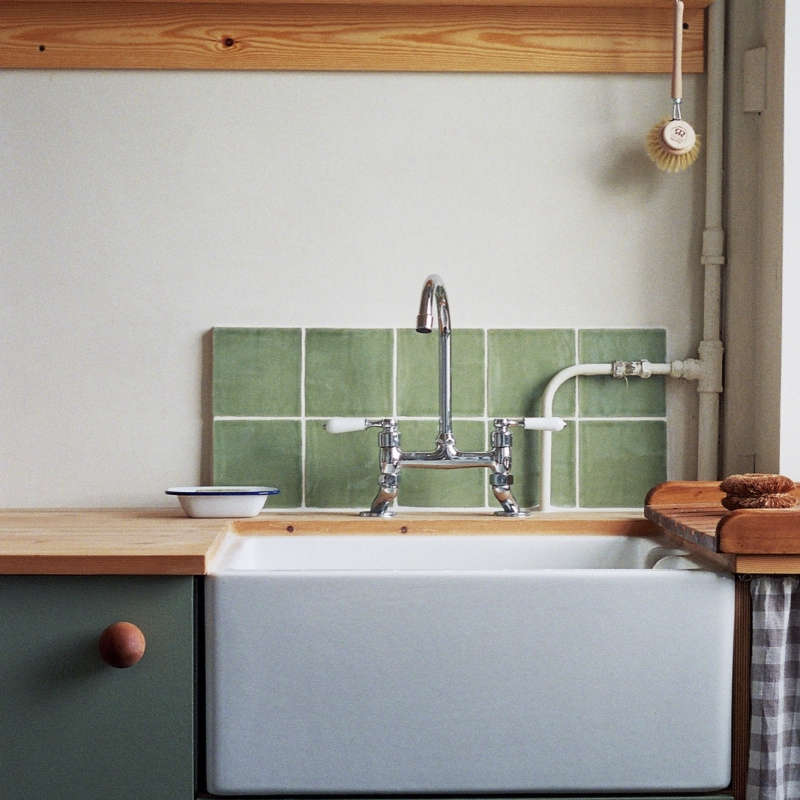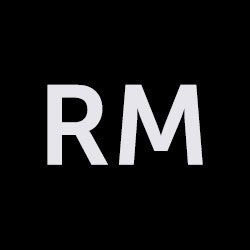Meet the unsung hero of the fixtures world: the wall-mounted faucet. Of all the decisions you need to make during a remodel, the location of the sink faucet may be an afterthought. But where the tap attaches matters—and can even save cleaning time, particularly in the kitchen, where wall-mounted taps are less common than in the bath. To get some professional input on the pros and cons of wall-mounted faucets, we talked with designer Malachi Connolly, who recently completed Julie’s renovation in Brooklyn Heights. (She opted for a wall-mounted kitchen faucet there and loves how it leaves a blank, clean space behind the sink.) Here’s what to know.

What is a wall-mounted faucet?
Unlike a deck-mounted tap (which is installed on the countertop behind the sink), a wall-mounted tap attaches onto the wall behind the sink, and extends over the sink. Wall-mounted faucets are available in a variety of styles, sizes, and finishes (and are well-suited to the DIY Faucets Made from Plumbing Parts trend too).
Why would I prefer a wall-mounted faucet over a deck-mounted one?
“Many people choose a wall-mounted fixture because of its clean appearance; it’s a style that’s both modern and utilitarian-looking,” says Connolly, adding, “You often see them in restaurant kitchens.”
To Connolly, a wall-mounted faucet becomes part of the backsplash as a design element. “When you put something on a wall, it’s more like a relief or a sculpture,” he says. “And the tiles around it—the color, the shape, the grout lines—are part of the composition.”

What are the advantages of a wall-mounted faucet?
The main plus: This type of tap makes it easier to keep the area in back of your sink clean. Dirt and calcium deposits tend to accumulate there, so the area is much easier to keep spick-and-span without hardware in the way.
And, as Connolly points out, if you’re a fan of the double-jointed (or articulated) faucet, which scissors back and forth to easily fill big pots with water, installing the fixture on the wall provides more range of motion.
What are the disadvantages?
A wall-mounted faucet is harder to install and costs around 30 percent more than the deck-mounted type. And since fewer styles are available, it’s not as easily replaced.
Another disadvantage: If you like to have a separate spray nozzle, you may need to install one on the deck. “Some wall-mount styles do have a sprayer,” says Connolly, “but having the hose dangling at the backsplash isn’t ideal.”

Is a special type of faucet needed?
Just make sure the fixture you buy is suited for wall-mounting. It’ll come with all the hardware needed to install it.
How high up should you position it?
“That depends on the shape of the tap,” says Connolly. “Figure on about eight to ten inches of clearance, measuring from the deck to the faucet head.”
How far out should it reach?
Connolly recommends that the faucet should extend out at least seven inches from the back of the sink, so you can wash your hands without banging them against the sink. So, if your countertop is 24 inches deep, that would put the spout about 11 inches from the wall.

Do you need to install a wall-mounted faucet on a special surface?
Since the fixture is supported by the plumbing pipes, rather than the wall, regular backer board for tiling (that is, a stable waterproof board) should suffice, says Connolly. And it doesn’t matter what type of backsplash you have. While it’s usually tile, you can also install the tap on a wall with waterproof paint or even on stone slab.
What else should you consider when installing a wall-mounted faucet?
With all these measurements, it’s best to have a professional install a wall-mounted tap. It starts with the plumber installing the pipes, which must be in positioned so the tap will be centered over the spot where the sink will be. “Once you install the plumbing, you can’t move it,” says Connolly. “Well, maybe by half an inch, but not enough to make a difference if it’s really out of whack.” For the next step, the cabinetmaker measures where the plumbing rough is installed so they know exactly where the sink cabinet needs to go.
And if your backsplash is tile, there’s another detail that should be attended to: For the best appearance, you’ll want the grout lines perfectly aligned with your wall-mounted tap so everything’s centered.

Are there situations where installing a wall-mounted tap isn’t possible?
It’s almost always possible to install a wall-mounted tap (unless you have a window directly behind the sink), but some conditions require extra work. Let’s say you want to install the faucet on an exterior-facing wall—which, in a cold-weather area, could lead to frozen pipes. “In those cases you’ll need to fur out the wall,” says Connolly; that is, build the wall out a few extra inches. “That gives you enough room to encase the pipes with two to three inches of high-density spray foam insulation.”
A stone slab backsplash also creates difficulties: You’ll need to have holes drilled for the faucet, and they must be precisely centered. “But if you’re able to afford a stone backsplash, you can afford a good contractor to coordinate all that work,” Connolly says.
Can I replace a deck-mounted fixture with a wall-mounted one?
Not without making other changes. If your existing tap is mounted on the sink, the sink will have one or more holes to accommodate that. So if you’re swapping out your tap, you’ll also have to replace your old sink with a new one that doesn’t have holes. If your faucet is installed on the counter itself, you’ll have to replace your countertop.
Looking for more tips on kitchen faucets? Start with our Remodeling 101: Kitchen Sinks and Faucets guide, where you’ll find help with faucet and sink selection, installation and maintenance. For more expert opinions on faucets, see our posts:
- 10 Easy Pieces: Architects’ Go-To Modern Kitchen Faucets
- 10 Easy Pieces: Pull-Down Sprayer Faucets
- 10 Easy Pieces: Wall-Mounted Industrial Faucets
N.B.: Featured image from the Bear Creek Bovidae Bath in Austin, Texas, an entrant in our 2017 Considered Design Awards.
Finally, get more ideas on how to evaluate and choose your bathroom sink and faucet in our Remodeling 101 Guide: Bathroom Sinks & Faucets.
Frequently asked questions
What are the benefits of wall-mounted faucets?
Wall-mounted faucets offer several advantages. They provide a sleek and minimalist look to the bathroom or kitchen, as the plumbing lines are hidden in the wall. They also free up countertop space, making it easier to clean and maintain. Additionally, wall-mounted faucets allow for greater flexibility in sink design and can be installed at a preferred height.
Can wall-mounted faucets be installed on any sink?
Wall-mounted faucets require specific sink configurations. The sink must have a corresponding hole or mounting option on the wall to accommodate the faucet. It's essential to consider the sink design and compatibility before choosing a wall-mounted faucet.
Are wall-mounted faucets more difficult to install?
Installing a wall-mounted faucet can be more complex than a traditional deck-mounted faucet. It involves running plumbing lines inside the wall, which may require professional installation or the assistance of a plumber. It's crucial to ensure proper positioning, alignment, and sealing to prevent leaks.
Do wall-mounted faucets require additional maintenance?
Wall-mounted faucets do not require specific additional maintenance compared to traditional faucets. Regular cleaning and maintenance practices, such as removing mineral deposits and checking for leaks, apply to all faucets. However, accessing the plumbing behind the wall may require some additional effort for repairs or maintenance.
Can wall-mounted faucets be installed in existing bathrooms or kitchens?
It is possible to install wall-mounted faucets in existing bathrooms or kitchens, but it may require modifications to the plumbing and wall structure. If you are considering retrofitting a wall-mounted faucet, it's recommended to consult with a professional to assess the feasibility and potential challenges.
Are wall-mounted faucets more prone to leaks?
Wall-mounted faucets, when properly installed, are not inherently more prone to leaks than traditional faucets. The key to preventing leaks is ensuring proper installation and using quality materials. Hiring a professional or experienced plumber can help minimize the risk of leaks.
Can wall-mounted faucets be used with any type of sink material?
Wall-mounted faucets can be used with various sink materials, including porcelain, ceramic, stainless steel, and stone. However, it's important to consider the sink's weight, stability, and installation requirements to ensure compatibility with the chosen wall-mounted faucet.






Have a Question or Comment About This Post?
Join the conversation